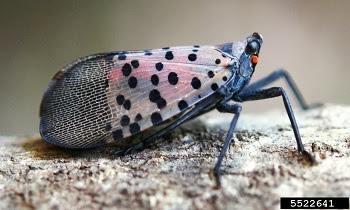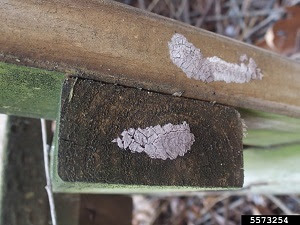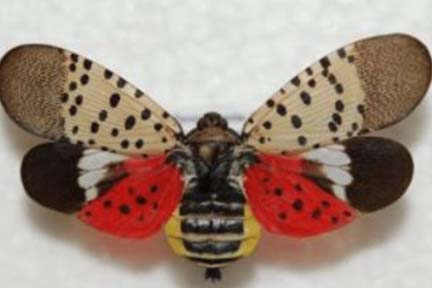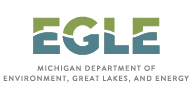| The following news release was issued earlier today by the Michigan Department of Agriculture and Rural Development.
For immediate release: August 11, 2022
Media contacts: Jennifer Holton, MDARD, 517-284-5724
Joanne Foreman, MDNR, 517-284-5814
This is Michigan’s first detection of this invasive bug
LANSING, Mich. – Today, Michigan Department of Agriculture and Rural Development (MDARD) Director Gary McDowell confirmed the state’s first detection of spotted lanternfly (Lycorma delicatula) in Michigan. A small population of spotted lanternfly was detected in Pontiac in Oakland County last week with the United States Department of Agriculture (USDA) confirming the finding on August 10.
 “Although not unexpected, this is certainly tough news to share due to its potential to for it to negatively impact Michigan’s grape industry,” said McDowell. “Spotted lanternfly has been moving closer to the state over the last few years. MDARD, along with our state, local and federal partners, has been working tirelessly to inform and educate growers and the public about this highly invasive insect.” “Although not unexpected, this is certainly tough news to share due to its potential to for it to negatively impact Michigan’s grape industry,” said McDowell. “Spotted lanternfly has been moving closer to the state over the last few years. MDARD, along with our state, local and federal partners, has been working tirelessly to inform and educate growers and the public about this highly invasive insect.” |
Spotted lanternfly is an invasive plant hopper native to eastern Asia. First found in the United States in 2014 in southeastern Pennsylvania, spotted lanternfly has spread rapidly through the eastern states. Confirmed observations of spotted lanternfly have since been recorded in Connecticut, Delaware, Indiana, Maryland, Massachusetts, New York, North Carolina, Ohio, Pennsylvania, Virginia, and West Virginia.
 “MDARD and MDNR are working with the United States Department of Agriculture to define the extent of the infestation,” said Mike Philip, MDARD’s Pesticide and Plant Pest Management Division Director. “Although we can’t pinpoint exactly how it got here, it likely hitchhiked on nursery stock brought in from an infested state and has possibly been here for several months. We are in the assessment stage of response, but it is important to note that typical pest management techniques have not proven effective for eliminating the pest in other states.” “MDARD and MDNR are working with the United States Department of Agriculture to define the extent of the infestation,” said Mike Philip, MDARD’s Pesticide and Plant Pest Management Division Director. “Although we can’t pinpoint exactly how it got here, it likely hitchhiked on nursery stock brought in from an infested state and has possibly been here for several months. We are in the assessment stage of response, but it is important to note that typical pest management techniques have not proven effective for eliminating the pest in other states.” |
 Spotted lanternfly moves easily on firewood, tires, campers, vehicles and more. Prevention and early detection are vital to limiting the spread of spotted lanternfly. If you find a spotted lanternfly egg mass, nymph or adult, take one or more photos, make note of the date, time and location of the sighting, and report it online to Eyes in the Field. Photos are necessary to verify a report and to aid in identification. Spotted lanternfly moves easily on firewood, tires, campers, vehicles and more. Prevention and early detection are vital to limiting the spread of spotted lanternfly. If you find a spotted lanternfly egg mass, nymph or adult, take one or more photos, make note of the date, time and location of the sighting, and report it online to Eyes in the Field. Photos are necessary to verify a report and to aid in identification.
Spotted lanternfly prefers to feed on the invasive tree of heaven (Ailanthus altissima), but also feeds on a wide range of plants including grapes, and trees such as black walnut, river birch, willow, sumac, and red maple. When feeding, spotted lanternfly produces a sticky liquid, honeydew, that can collect on the ground or surrounding vegetation. This results in the growth of sooty mold, which can discolor and kill plants. |
“The research community is still learning about the spotted lanternfly and its potential for impacting our natural resources as well as treatments to eliminate this pest,” said Joanne Foreman, invasive species communications coordinator for the Michigan Department of Natural Resources. “It also could have an effect on important timber species statewide. What the long-term impact might be is unknown.”
What can you do?
- Check Your Vehicle: Before leaving a parking lot or work site, inspect vehicles for spotted lanternfly egg or insects. Check doors, sides, bumpers, wheel wells, grills, and roofs. If found, destroy any eggs or insects you find.
- Park with Windows Closed: The spotted lanternfly and its nymphs can enter vehicles unsuspectedly. When parked, make sure to keep windows closed.
- Remove and Destroy Pests: Crush nymphs and adult insects. Scrape egg masses into a plastic bag containing hand sanitizer or rubbing alcohol to kill them.
- Remove Host Trees: Spotted lanternflies prefer the ailanthus tree, also known as “tree of heaven.” Try to remove trees from properties to avoid attracting spotted lanternfly.
- Report Sightings: Send in required photos to Eyes in the Field. Photos are necessary to verify a report and to aid in identification.
For additional information on identifying or reporting spotted lanternfly, visit Michigan.gov/SpottedLanternfly. You can also learn more at USDA’s Spotted Lanternfly website found at USDA APHIS | Spotted Lanternfly.
/Note to editors: Accompanying photos are available below for download. Credits and suggested captions follow.
SLF folded wings: Spotted lanternflies are more likely to be seen with wings folded. Look for grey to brown wings with black spots, and black-striped wing tips. Photo courtesy of Lawrence Barringer, Pennsylvania Department of Agriculture, Bugwood.org.
SLF wings: Adult spotted lanterfly’s bright wing coloration is hidden when wings are closed. Photo courtesy of Robert Gardner, Bugwood.org.
SLF egg mass: Spotted lanternflies may lay egg masses on vehicles, outdoor furniture or other items that can be transported to new areas, leading to new infestations. Photo courtesy of Emilie Swackhammer, Penn State University, Bugwood.org.
Spotted lanternfly.jpg: Earlier spotted lanternfly life stages include a black, spotted beetle which later morphs to red, as indicated in the top right and left corners of the collage./ |


















